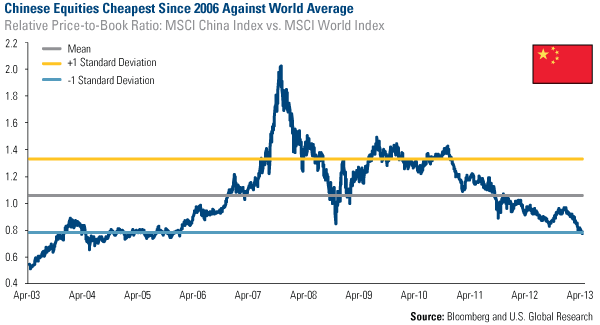Emerging Markets Radar (April 22, 2013)
Strengths
- China’s March retail sales were up 12.6 percent, in line with market expectations. China’s home sales rose 69 percent to Rmb 1.2 trillion in the first quarter, the most growth in three years. The country’s March passenger vehicle sales were up 17 percent, and March foreign direct investment was up 5.7 percent.
- The Indonesian government is socializing the idea to increase the subsidized fuel price by 44-55 percent to 6,500-7,000 rupiah effective May 2013. If this is done, it will be one more step taken to correct the structural inefficiency in the economy, though it might temporarily cause inflation pressure.
- Chinese property names were well supported this week following comments attributed to Premier Li Keqiang that the government shouldn’t be too harsh on the sector and China should hold off on expanding the property tax across the country. In separate news, the Hainan province refused to issue housing tightening measures.
- The falling crude price, rising Rmb exchange rate, and increasing long-haul Chinese tourists traveling overseas are supporting the profitability of Chinese airline companies.
- The Korean government announced a bigger-than-expected supplementary budget of 19.3 trillion won to stimulate the economy.
- February trade balance figures for Colombia, as released this week by the country’s official statistics office, came in at $386.4 million, beating the expectations of a $204.5 million trade surplus. It is worth mentioning the Colombia peso has weakened more than 4 percent year-to-date following 100 basis points of central bank rate cuts and the lowest inflation reading in six decades. The situation places Colombia ahead of most of its South American peers who continue to battle lower commodity export prices and widening trade deficits.
Weaknesses
- China’s first-quarter GDP growth slowed to 7.7 percent versus the market expectation of 8 percent. China’s March industrial production was up 8.9 percent versus the market expectation of 10.1 percent, and fixed asset investments growth was up 20.9 percent year-to-date versus the market expectation of 21.3 percent. In the first quarter, China was busy with its leadership transition and replacing the Ministry of Railway by China Railway Corporation, which had delayed projects tendering and investments. The housing market tightening policy also was a negative factor that caused lower new housing starts and investments.
- Sina.com reported that CBRC told lenders to control total outstanding loans to local government financing vehicles, and the size cannot rise this year, citing guidelines dated April 9.
- Stock markets in Latin America had a rough week following the selloff in commodities and commodity-related industries. The Peruvian IGBVL exchange fell by as much as 7.09 percent, driven down by the heavy weight of precious metal mining companies. The Colombian IGBC stock exchange was down 3.04 percent with energy companies being the biggest laggards. Finally, Brazil’s Bovespa index was down 3.77 percent for the week with weakness across all commodity sectors.
Opportunities
- As shown in the graph above, Chinese equities represented by the MSCI China Index are one standard deviation cheaper than the world average represented by the MSCI World index. Particularly, H-share equities (Hong Kong-listed Chinese companies), as measured by the HSCEI Index, are trading at 8.7 times price-earning multiple and 3.53 percent dividend yield, the cheapest among their Asia peers.
- Turkey is planning to pass legislation to allow the government to guarantee municipal bond issues, and will facilitate the financing of big projects (such as hospital construction and the third bridge across the Bosphorus).
- The International Monetary Fund (IMF) published its updated GDP growth forecasts for the years of 2013 and 2014. The organization lowered its estimate for global economic growth from 3.5 percent to 3.3 percent in 2013. However, the report also highlighted the expected greater than average growth in most Latin American nations. The GDP growth estimates for Paraguay and Peru are above 6 percent, while Bolivia, Chile, Colombia, and Ecuador are predicted to grow at a rate greater than 4 percent. The IMF attributes the outperformance to strong internal demand as well as favorable financing conditions.
- Primary spending has increased as a share of GDP in a number of emerging market countries, and this has helped to contribute to a steady increase in the emerging markets trade deficit against a background of weak export growth – but lower oil prices might slow this trend.
Threats
- China’s housing tightening policy showed its negative effect in slowing down GDP growth in the first quarter.
- In Malaysia, questions have been raised over the use of non-financial public sector enterprises (NFPEs) under the Economic Transformation Programme (ETP). While the Federal government deficit fell to 4.5 percent of GDP in 2012 (from 4.8 percent in 2011), the consolidated public sector deficit, which includes NFPEs, was projected to surge to a record 10.5 percent of GDP in 2012 (from 3.3 percent in 2011).
- Mexican lawmakers approved legislation requiring mining companies to pay a 4 percent royalty on net profits before taxation. Projects that are not yet in production will be taxed on a per-hectare amount to be defined. Lawmakers anticipate the new tax will bring $250 to $500 million per year in additional tax revenues, of which mining municipalities will retain 70 percent. In our opinion, the new law goes against President Pena Nieto’s proposed program to increase competitiveness across the country as the platform for future growth.














